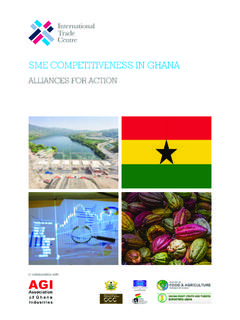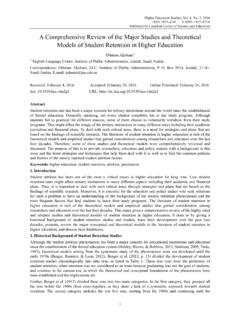Transcription of Consumer Protection in E-commerce - OECD
1 OECD 2015 Consumer Protection in E-commerceOECD Recommendation2016 DIGITAL ECONOMY POLICY LEGAL INSTRUMENTSC onsumer Protection in E-commerceOECD RecommendationDISCLAIMERThis document and any map included herein are without prejudice to the status of or sovereignty over any territory, to the delimitation of international frontiers and boundaries and to the name of any territory, city or cite this publication as:OECD (2016), Consumer Protection in E-commerce : OECD Recommendation, OECD Publishing, Paris, to OECD publications may be found on line at: OECD 2016 You can copy, download or print OECD content for your own use, and you can include excerpts from OECD publications, databases and multimedia products in your own documents, presentations, blogs, websites and teaching materials, provided that suitable acknowledgment of the source and copyright owner is given. All requests for public or commercial use and translation rights should be submitted to Requests for permission to photocopy portions of this material for public or commercial use shall be addressed directly to the Copyright Clearance Center (CCC) at or the Centre fran ais d exploitation du droit de copie (CFC) at has evolved dramatically since 1999, when the OECD Council adopted the first international instrument for Consumer Protection in the Context of Electronic commerce ( 1999 Recommendation ).
2 On 24 March 2016, the OECD Council revised this instrument and the Recommendation of the Council on Consumer Protection in E-commerce ( the revised Recommendation ) now addresses new and emerging trends and challenges faced by consumers in today s dynamic E-commerce called for in the 1998 OECD Ministerial Conference on The Borderless World: Realising the Potential of Global Electronic commerce , the 1999 Recommendation set forth the core characteristics of Consumer Protection for electronic commerce : fair and transparent business and advertising practices, information about businesses, goods and services, transactions, as well as adequate dispute resolution and redress mechanisms, payment Protection , privacy, and education. Responding again to the invitation of Ministers at the 2008 Ministerial on the Future of the Internet Economy, the OECD undertook a review of the 1999 Recommendation to consider how to further encourage consumers to embrace the opportunities of E-commerce .
3 Beginning with a conference held in 2009 in Washington, , on Empowering E-Consumers: Strengthening Consumer Protection in the Internet Economy, the OECD Committee on Consumer Policy (CCP) researched and analysed trends and policy challenges arising in mobile and online payments, the purchase of intangible digital content products, and participative E-commerce . This work outlined the many benefits that E-commerce had brought over a decade to consumers, including wider choices at competitive prices, as well as easy-to-use and more secure payment options. The work however also pointed to the higher complexity of the online environment and related risks for consumers. It showed that, for example, consumers understanding of their rights and obligations was often challenged when they make purchases through non-traditional payment mechanisms, such as mobile phone bills or pre-paid cards, or when they acquire digital content products, such as apps or e-books.
4 FOREWORD . 3 OECD 20164 . Consumer Protection IN E-commerce OECD 2016 The OECD Consumer Policy Toolkit further highlighted that when consumers use mobile devices for E-commerce in an on the go context, their tendency to take decisions based on heuristic techniques is exacerbated. Unauthorised charges, misleading and fraudulent commercial practices also remain problematic. Following its thorough review, in 2014, the Committee agreed to revise the 1999 Recommendation to address the challenges identified and achieve effective Consumer Protection while stimulating innovation and competition in the market. Key new developments in E-commerce addressed by the revised Recommendation include: Non-monetary transactions. Consumers increasingly acquire free goods and services in exchange for their personal data and these transactions are now explicitly included in the scope of the Recommendation.
5 Governments and stakeholders are called upon to consider ways to provide redress to consumers experiencing a problem with such transactions. Digital content products. Transactions involving digital content often come with technical or contractual access or usage limitations and many consumers have difficulty understanding their rights and obligations. New language has been added to clarify that consumers should be provided with clear information about such limitations, as well as on functionality and interoperability. Active consumers. Current E-commerce business models increasingly blur the boundaries between consumers and businesses, with consumers playing a participatory role in product promotion and development, and entering into transactions with other consumers. The scope of the Recommendation has therefore been broadened and it now encompasses business activities that facilitate Consumer -to- Consumer transactions.
6 A new provision is added to ensure that Consumer endorsements are truthful and transparent. Mobile devices. The growing use of mobile devices for E-commerce brings a number of technical challenges to making information disclosures effective ( on small screens) and can constrain record keeping by consumers. Two new provisions are included to highlight the need to account for the technological limitations or special characteristics of the device used. Privacy and security risks. Consumer data is at the core of many E-commerce services and elevates privacy and security risks. The Recommendation recalls the need to address these risks consistent with other OECD instruments and includes two new provisions highlighting specific protections of particular importance for B2C E-commerce . Payment Protection . Recognising that the level of payment Protection can vary depending on the type of payment mechanism used, the Recommendation calls on governments and stakeholders to work together to develop minimum levels of Consumer Protection across payment mechanisms.
7 Product safety. In a number of countries, a range of unsafe products, which have been prohibited from sale or recalled from the offline retail market, are available in E-commerce . A new provision is added to ensure that unsafe products are not offered to consumers online, and that businesses cooperate with the relevant authorities to address the addition, the Recommendation updates several other provisions. One relates to the essential role of Consumer Protection authorities and the need to enhance their ability to protect consumers in E-commerce and to exchange information and co-operate in cross-border matters. Another calls for improving the evidence base for policy making in this area through empirical research based on the insights gained from information and behavioural revised Recommendation was developed by the CCP, working in close consultation with business, civil society, and the Internet technical community, under the leadership of its current Chair, Nathalie Homobono, and former Chair, Michael Jenkin.
8 During the preparation of the Recommendation, the CCP intensified its co-operation with other international forums, such as the United Nations Conference on Trade and Development (UNCTAD), the Association of Southeast Asia Nations (ASEAN) and the International Consumer Protection and Enforcement Network (ICPEN). FOREWORD. 5 OECD 2016 Recommendation of the Council on Consumer Protection in E-commerce24 March 2016 C(2016)13 THE COUNCIL, HAVING REGARD to Article 5 b) of the Convention of the Organisation for Economic Co-operation and Development of 14 December 1960; HAVING REGARD to the Recommendation of the Council concerning Guidelines for Consumer Protection in the Context of Electronic commerce [C(99)184/FINAL], which this Recommendation replaces;HAVING REGARD to the Recommendation of the Council concerning Guidelines for Protecting Consumers from Fraudulent and Deceptive Commercial Practices Across Borders [C(2003)116]; the Recommendation of the Council on Consumer Dispute Resolution and Redress [C(2007)74]; the Declaration for the Future of the Internet Economy (The Seoul Declaration) [C(2008)99].
9 The Recommendation of the Council on Principles for Internet Policy Making [C(2011)154]; the Recommendation of the Council concerning Guidelines Governing the Protection of Privacy and Trans-border Flows of Personal Data ( Privacy Guidelines ) [C(80)58/Final, as amended]; the Recommendation of the Council on Consumer Policy Decision Making [C(2014)30]; the Recommendation of the Council on Digital Security Risk Management for Economic and Social Prosperity ( Security Risk Recommendation ) [C(2015)115];RECOGNISING the benefits of E-commerce to consumers, which include easy access through a range of devices to a variety of goods and services, including digital content products, offered by an expanding array of businesses at competitive prices, with convenient payment options; RECOGNISING the dynamic and innovative character of the E-commerce marketplace, which enables consumers to gather, compare, review and share information about goods and services, and fosters the development of new business models, some of which facilitate Consumer -to- Consumer transactions; RECOGNISING that the ease and speed of engaging in E-commerce , at anytime, anywhere, and in particular across borders, may create situations which are unfamiliar to consumers and put their interests at risk;8.
10 Consumer Protection IN E-commerce OECD 2016 RECOGNISING the need to address a number of Consumer challenges related to information disclosure, misleading or unfair commercial practices, confirmation and payment, fraud and identity theft, and dispute resolution and redress;RECOGNISING the need to equip Consumer Protection enforcement authorities with the ability to effectively protect consumers in E-commerce and to exchange information and co-operate in cross-border matters;MINDFUL of the increasing privacy and security risks faced by consumers in E-commerce and the need to effectively address those risks to enhance Consumer trust in E-commerce , consistent with the Privacy Guidelines and Security Risk Recommendation; RECOGNISING the value to governments, businesses and consumers of clear guidance as to the core characteristics of effective Consumer Protection in E-commerce , which can be supplemented by additional measures for the Protection of consumers in E-commerce ;RECOGNISING the importance of E-commerce policies that are innovation-friendly, technology neutral and informed by evidence and insights from information and behavioural economics;RECOGNISING the value of inclusive and transparent multi-stakeholder processes in developing flexible and globally scalable policies for protecting consumers in E-commerce ;EMPHASISING that the appropriate allocation of responsibility for the Protection of consumers among relevant E-commerce actors is key to promoting Consumer welfare and enhancing Consumer trust; On the proposal of the Committee on Consumer Policy:I.

















